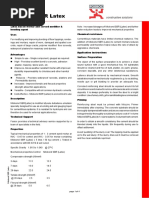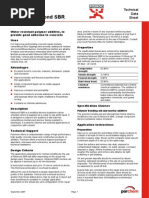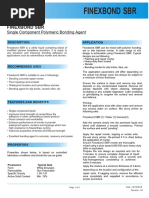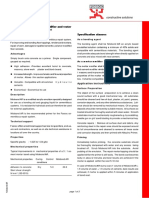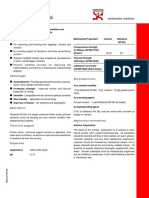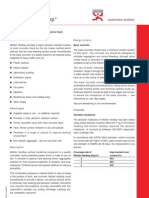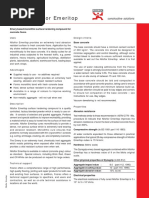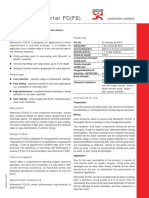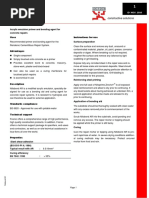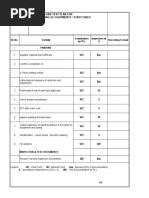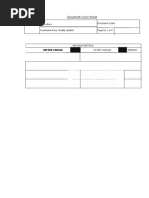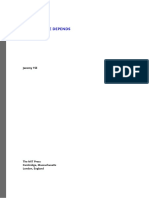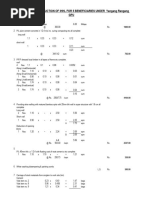Nitobond SBR TDS
Nitobond SBR TDS
Uploaded by
Hariom GuptaCopyright:
Available Formats
Nitobond SBR TDS
Nitobond SBR TDS
Uploaded by
Hariom GuptaOriginal Description:
Original Title
Copyright
Available Formats
Share this document
Did you find this document useful?
Is this content inappropriate?
Copyright:
Available Formats
Nitobond SBR TDS
Nitobond SBR TDS
Uploaded by
Hariom GuptaCopyright:
Available Formats
Fosroc®
Nitobond® SBR constructive solutions
Water resistant polymer additive / bonding Properties
agent, to provide improved adhesion to The results listed below were achieved by assessing the
concrete mechanical properties of a 3:1 sand:cement mortar containing
Nitobond SBR in the proportions 4 litres per 20kg cement.
Uses The test methods used were in full accordance with BS 6319
at 28 days - air cured.
For improving and bonding concrete repair mortars,
cementitious floor toppings and screeds, waterproof renders Compressive 62 MPa
and cementitious slurries. Cementitious mortars are alkaline strength:
in nature and will protect embedded steel reinforcement.
Mortars produced with Nitobond SBR may be used for Tensile strength: 3.3 MPa
horizontal, vertical and overhead repair work. Flexural strength: 9 MPa
Slant shear bond: 53 MPa
Advantages VOC content: 29g / litre
Excellent bond to concrete, masonry, stonework, plaster Chemical Cementitious materials have limited
and blockwork resistance: chemical resistance. The addition of
Improved tensile and flexural properties allow Nitobond SBR to cement mortars
thinner applications reduces permeability and therefore
helps reduce the rate of attack by
Single component liquid can be easily gauged aggressive chemicals, acid gases
as required and water
Improves cohesion and workability
Improves mortars to provide waterproof repairs, renders
Application Instructions
and toppings which are highly resistant to freeze/thaw
Preparation
cycling
Saw cut or cut back the extremities of the repair locations to
a depth of at least 10mm to avoid feather-edging and to provide
Description a square edge. Break out the complete repair area to a minimum
Nitobond SBR is a modified styrene butadiene rubber emulsion depth of 6mm up to the sawn edge.
which is supplied as a ready to use white liquid. It is designed
to improve the qualities of site-batched cementitious mortars Clean the surface and remove any dust, unsound or
and slurries. Being resistant to hydrolysis, it is ideal for internal contaminated material, plaster, oil, paint, grease, corrosion
and external applications in conjunction with cement. deposits or algae. Where breaking out is not required, roughen
the surface and remove any laitance by light scabbling or
grit-blasting.
Design Criteria
Oil and grease deposits should be removed by steam cleaning,
The application parameters for mortars modified by the use
detergent scrubbing or the use of a proprietary degreaser.
of Nitobond SBR will differ depending on the actual mix
The effectiveness of decontamination should then be assessed
design used. Generally, however, Nitobond SBR mortars
by a pull-off test.
can be applied in sections up to 40mm thickness in horizontal
locations and up to 15mm in vertical locations. The thickness Expose fully any corroded steel in the repair area and remove
achievable in overhead locations without the use of formwork all loose scale and corrosion deposits. Steel should be cleaned
is largely dependent on the profile of the substrate. Vertical to a bright condition paying particular attention to the back of
and overhead sections greater than those stated above may exposed steel bars. Grit-blasting is recommended for this
be built up in layers but may sometimes be possible in a process.
single application dependent on the actual size and
Where corrosion has occurred due to the presence of chlorides,
configuration of the repair area, and the volume of any
the steel should be high-pressure washed with clean water
exposed reinforcing steel. Nitobond SBR mortars should
immediately after grit-blasting to remove corrosion products
not be applied at less than 6mm thickness. Thicknesses up
from pits and imperfections within its surface.
to 40mm in a single application can be achieved by the use
of formwork.
Reinforcing steel priming
Apply 1 full coat of Nitoprime Zincrich to any exposed steel
reinforcement and allow to dry before continuing. If any doubt
exists about having achieved an unbroken coating, a second
application should be made and, again, allowed to dry before
continuing.
Feb 2020 Page 1
Fosroc®
Nitobond® SBR
Substrate priming Note: these mix designs are based on the use of dry sand
The substrate should be thoroughly soaked with clean water and aggregate. Adjustments must be made to the water demand
and any excess removed prior to commencement. A slurry relative to the moisture content of the sand and aggregate
primer should be prepared consisting of 1 volume Nitobond used.
SBR to 1 volume clean water to 3 volumes fresh cement. To It should also be noted that, due to the frequent inconsistencies
obtain a smooth consistency, the cement should be blended of site-stored materials and variable conditions, actual yields
slowly into the premixed liquids. The slurry primer should be and results may differ from those published above.
stirred frequently during use to offset settlement.
Weigh the cement, sand and, where required, aggregate into
The slurry primer should be scrubbed well into the surface of
the mixer and dry blend together for 1 minute. With the machine
the concrete. Avoid applying too thickly and avoid ‘puddling’.
in operation, add the pre-mixed Nitobond SBR and clean
The repair mortar, topping or render must be applied on to
water. Continue mixing for 3 minutes to ensure complete
the wet slurry primer. If the slurry primer dries before application
dispersal into the sand and cement. Make any small adjustment
of the mortar, it must be removed (ground off) and the area
to the quantity of clean water but do not significantly exceed
reprimed before continuing.
the litreage shown above.
In exceptional circumstances, e.g. where a substrate/repair
barrier is required or where the substrate is likely to remain Additional water should be kept to a minimum. Continue mixing
permanently damp, Nitobond EP bonding aid should be used. up to a maximum of 5 minutes until a smooth and fully
Contact Fosroc for further information. homogeneous consistency is achieved with the required
workability and application properties. It is critical that allowance
Mixing is made for the moisture content of the sand and aggregate,
particularly where they are stored on site.
Care should be taken to ensure that Nitobond SBR mortars
are thoroughly mixed. A forced-action mixer is essential. Mixing
at a slow speed (400/500 rpm) in a suitably sized drum using Application
appropriate equipment such the Ransom 140 x 600 M14 For application to all surfaces, Nitobond SBR mortars, toppings
Helical mixing paddle (product code: N4020892-UNIT) fitted and renders must be well-compacted on to the primed substrate
to a heavy-duty 1600W mixer, such as Ransom 1602 E (product by trowel. It is frequently beneficial to work a thin layer of the
code: NP7EV160-UNIT) or equivalent is acceptable for small mortar into the slurry primer and then build the mortar on to
mixes. this layer. Exposed steel reinforcement should be completely
A wide range of mix designs is achievable using Nitobond encapsulated by the mortar.
SBR. Nitobond SBR mortars can be applied at a minimum thickness
Typical designs are detailed below: of 6mm and up to 40mm thickness, dependent on the location
and configuration of the repair zone. The thickness achievable
1. Patching and repair mortar: 20kgs GP Cement + 60kgs in overhead locations without the use of formwork is largely
grade 16/30 sharp sand + 4 litres Nitobond SBR + 3 litres dependent on the profile of the substrate. Refer to the
(approximately) clean water. Yield 38 litres. Recommended recommended thicknesses shown in the ‘Mix design’ section
thickness: 6mm - 40mm above. If the recommended thickness is exceeded and sagging
2. Heavy-duty floor screed: 20kgs GP Cement + 30kgs occurs, the affected section must be completely removed and
3mm to 6mm crushed rock + 30kgs grade 16/30 sharp reapplied in accordance with the procedure described above.
sand + 2.5 litres Nitobond SBR + 2.5 litres (approximately) The use of formwork may facilitate achieving the required
clean water. Yield 37 litres. The screed should be of a build. If formwork is used, it should have properly sealed faces
semi-dry cohesive consistency. Recommended thickness: to ensure that no water is absorbed from the repair material.
10mm - 40mm Where thicker sections up to a total thickness of 40mm are
3. Render: 20kgs GP Cement + 60kgs grade 16/30 sharp to be built up by hand or trowel application, the surface of the
sand + 2.5 litres Nitobond SBR + 2.5 litres (approximately) intermediate layers should be scratch-keyed and cured with
clean water. Yield 37 litres. The render should be of a diluted Nitoprime 330. Application of the slurry primer and a
semi-dry cohesive consistency. Recommended thickness: further application of Nitobond SBR mortar may proceed as
6mm - 9mm soon as this layer has set.
4. Bonding mortar for tiles, etc: 20 kgs GP Cement + 50kgs Finishing
grade 16/30 sharp sand + 4 litres Nitobond SBR + 3 litres Nibobond SBR mortars can be finished with a steel, plastic
(approximately) clean water. Yield 33 litres. Water is or wood float, or by a damp sponge technique, to achieve the
adjusted to give a firm mortar. Support where necessary desired surface texture. The completed surface should not be
until the mortar is set. Recommended thickness: 6mm to overworked.
40mm.
constructive solutions Page 2
Fosroc®
Nitobond® SBR
Low temperature working Supply
In cold conditions down to 5°C, the use of warm water (up to
30°C) is advisable to accelerate strength development. Normal Nitobond SBR 20 litre: FC323105-20L
precautions for winter working with cementitious materials
should then be adopted. Coverage and yield
High temperature working Nitobond SBR: Refer to mix designs
At ambient temperatures above 35°C, the material should be Nitobond SBR (as Approximately 2 to 3m²/litre
stored in the shade and cool water used for mixing. slurry primer):
Notes: the coverage figures for liquid products are theoretical
Curing - due to wastage factors and the variety and nature of possible
Nitobond SBR mortars, toppings and renders are cement- substrates and mix design used, practical coverage figures
based. In common with all cementitious materials, they must will be reduced.
be cured immediately after finishing in accordance with good
concrete practice. The use of one of Fosroc’s Concure curing Storage
compounds, sprayed on to the surface of the finished mortar
in a continuous film, is recommended. In harsh drying Nitobond SBR should be kept in a dry store in the original,
conditions, supplementary curing with polythene sheeting unopened packaging.
must be used. Nitobond SBR should be protected from frost.
Cleaning
Nitobond SBR should be removed from tools, equipment and
mixers with clean water immediately after use. Cured material
can only be removed mechanically.
Limitations
Nitobond SBR mortars, toppings and renders should not be
applied when the temperature is 5°C and falling. Neither
should they be exposed to moving water during application.
Exposure to heavy rainfall prior to the final set may result in
surface scour. If any doubts arise concerning temperature or
substrate conditions, consult Fosroc.
Important notice
A Safety Data Sheet (SDS) is available from the Fosroc website. Read the SDS and TDS carefully prior to use as application or performance data may change from time to time. In emergency,
contact any Poisons Information Centre (phone 13 11 26 within Australia) or a doctor for advice.
Product disclaimer
This Technical Data Sheet (TDS) summarises our best knowledge of the product, including how to use and apply the product based on the information available at the time. You should read
this TDS carefully and consider the information in the context of how the product will be used, including in conjunction with any other product and the type of surfaces to, and the manner in
which, the product will be applied. Our responsibility for products sold is subject to our standard terms and conditions of sale. Parchem does not accept any liability either directly or indirectly for
any losses suffered in connection with the use or application of the product whether or not in accordance with any advice, specification, recommendation or information given by it.
*Manufactured and sold under license from Fosroc Parchem Construction Supplies Pty Ltd
International Limited. Fosroc and the Fosroc logo are trade 7 Lucca Road, Wyong NSW 2259
marks of Fosroc International Limited, used under license. Ph: 1800 812 864
www.fosroc.com.au ABN 80 069 961 968
Distributed in New Zealand by: Concrete Plus Ltd
constructive solutions 150 Hutt Park Road Gracefield Ph: 0800 657 156
Page 3 www.fosroc.co.nz NZBN 9429033691282
You might also like
- TDS VETOBOND pb434Document4 pagesTDS VETOBOND pb434PeshteenNo ratings yet
- Nitobond SBR TDS PDFDocument3 pagesNitobond SBR TDS PDFravi0% (1)
- 6.Nitobond SBRDocument19 pages6.Nitobond SBRalixondomingoNo ratings yet
- Nitobond SBRDocument4 pagesNitobond SBRzishan khanNo ratings yet
- Fosroc Nitobond SBRDocument4 pagesFosroc Nitobond SBRqc.liwanNo ratings yet
- Nitobond EP Data Sheet: Specialist Construction Supplies For Repair, Maintenance, Building & InfrastructureDocument5 pagesNitobond EP Data Sheet: Specialist Construction Supplies For Repair, Maintenance, Building & InfrastructureHariom GuptaNo ratings yet
- TDS Nitobond SBR India5Document3 pagesTDS Nitobond SBR India5vinayNo ratings yet
- Fosroc Nitobond SBR 300Document3 pagesFosroc Nitobond SBR 300arunpatidar8No ratings yet
- Nitobond SBR 300Document3 pagesNitobond SBR 300ramNo ratings yet
- Nitobond SBRDocument4 pagesNitobond SBRAzhar ShaikhNo ratings yet
- Nitobond SBR Latex: Constructive SolutionsDocument3 pagesNitobond SBR Latex: Constructive SolutionsKamal RaoNo ratings yet
- TDS Nitobond SBR Latex India4Document3 pagesTDS Nitobond SBR Latex India4rakeshNo ratings yet
- Nitobond SBR PDFDocument4 pagesNitobond SBR PDFhelloitskalaiNo ratings yet
- Nitobond SBR LatexDocument4 pagesNitobond SBR Latexturhan.masabihNo ratings yet
- Expanbond SBRDocument5 pagesExpanbond SBRAmar WadoodNo ratings yet
- PACTOBond SBR-DatasheetDocument2 pagesPACTOBond SBR-DatasheethidiNo ratings yet
- Faircrete SBR Mortar and Screed Modifier Cum Bonding AgentDocument2 pagesFaircrete SBR Mortar and Screed Modifier Cum Bonding Agentkk777kk77777No ratings yet
- Nitobond SBR TDS PDFDocument3 pagesNitobond SBR TDS PDFJong Dollente Jr.No ratings yet
- Nitobond AR: Constructive SolutionsDocument2 pagesNitobond AR: Constructive SolutionsMohammad ArslanNo ratings yet
- Nitobond ArDocument2 pagesNitobond Aradilabad newsNo ratings yet
- Nitobond AR PDFDocument4 pagesNitobond AR PDFRajNo ratings yet
- Nitobond ArDocument46 pagesNitobond ArGavriel NgNo ratings yet
- Bonding AgentDocument7 pagesBonding Agentmohamed ragabNo ratings yet
- Finexbond SBR-tds-nws (1)Document3 pagesFinexbond SBR-tds-nws (1)Abhimani CreationsNo ratings yet
- ReArm SBR 35-Ver 8 (HO)Document3 pagesReArm SBR 35-Ver 8 (HO)ebadatmallick6No ratings yet
- 6.6 Bondit SBRDocument4 pages6.6 Bondit SBRCristal Haze VictoriaNo ratings yet
- TDS Nitobond AR IndiaDocument3 pagesTDS Nitobond AR IndiaAnonymous XVEucVMsENo ratings yet
- S BR CombinedDocument6 pagesS BR CombinedsajjaduetNo ratings yet
- Nitobond AR Std.Document4 pagesNitobond AR Std.Dinesh Kumar PatelNo ratings yet
- Advabond SBR TDSDocument2 pagesAdvabond SBR TDSMohammed AbugharbiehNo ratings yet
- Nitoflor HardtopDocument4 pagesNitoflor HardtopArunashish Mazumdar100% (1)
- Guncrete: High Strength, Low Shrinkage, High Build Spray Applied Repair MortarDocument4 pagesGuncrete: High Strength, Low Shrinkage, High Build Spray Applied Repair MortarZac Francis DaymondNo ratings yet
- Guncrete: High Strength, Low Shrinkage, High Build Spray Applied Repair MortarDocument4 pagesGuncrete: High Strength, Low Shrinkage, High Build Spray Applied Repair MortarZac Francis DaymondNo ratings yet
- 6 2 3 6 1 Polybond SBR PDFDocument2 pages6 2 3 6 1 Polybond SBR PDFHtun ZarniNo ratings yet
- Nitobond AR STD.: Constructive SolutionsDocument4 pagesNitobond AR STD.: Constructive SolutionsVarun GuggilamNo ratings yet
- Fosroc Nitoflor Emeritop: Constructive SolutionsDocument4 pagesFosroc Nitoflor Emeritop: Constructive SolutionsVincent JavateNo ratings yet
- Tds Nitobond Ar STD Bfl5Document3 pagesTds Nitobond Ar STD Bfl5Ahmed Ben HmidaNo ratings yet
- Nitomortar FC PDFDocument2 pagesNitomortar FC PDFganmosesNo ratings yet
- Nitoflor Hardtop PDFDocument4 pagesNitoflor Hardtop PDFVincent JavateNo ratings yet
- TDS Nitoflor Hardtop Standard BFLDocument4 pagesTDS Nitoflor Hardtop Standard BFLdivithNo ratings yet
- MasterEmaco SBR 2Document3 pagesMasterEmaco SBR 2Radja NurNo ratings yet
- Sika Rapid Repair Mortar PDS - CE - PDFDocument6 pagesSika Rapid Repair Mortar PDS - CE - PDFLouis BirNo ratings yet
- TDS - Nitomortar SDocument4 pagesTDS - Nitomortar SDipNo ratings yet
- Brushbond RFX PDFDocument2 pagesBrushbond RFX PDFDeep GandhiNo ratings yet
- Sika MonoTop 615 PDS (CE)Document6 pagesSika MonoTop 615 PDS (CE)Mihai CîrsteaNo ratings yet
- Brush BondDocument4 pagesBrush BondGibbs PerNo ratings yet
- Adva SBR TDSDocument2 pagesAdva SBR TDSMohammed AbugharbiehNo ratings yet
- TDS Nitoflor Hardtop Standard India 2Document4 pagesTDS Nitoflor Hardtop Standard India 2Afri IklilNo ratings yet
- Nitomortar S: Constructive SolutionsDocument4 pagesNitomortar S: Constructive SolutionsjitendraNo ratings yet
- Fosroc Brushbond: Uses Design CriteriaDocument4 pagesFosroc Brushbond: Uses Design CriteriaSabyasachi BangalNo ratings yet
- Fosroc Nitomortar FC (FS) : Constructive SolutionsDocument2 pagesFosroc Nitomortar FC (FS) : Constructive SolutionsVincent JavateNo ratings yet
- StoCrete SBRDocument3 pagesStoCrete SBRBMZNo ratings yet
- Nitobond ARDocument2 pagesNitobond ARDED 11 Pasar Jawa BaratNo ratings yet
- Fosroc Nitomortar HB: Constructive SolutionsDocument4 pagesFosroc Nitomortar HB: Constructive SolutionsVincent JavateNo ratings yet
- Nitomortar FCFSDocument2 pagesNitomortar FCFSMansoor AliNo ratings yet
- RCT-ConRep FR MortarDocument2 pagesRCT-ConRep FR MortarFahad NadeemNo ratings yet
- (Sika) Sika Monotop 612Document5 pages(Sika) Sika Monotop 612_at_to_No ratings yet
- Functional Polymer Coatings: Principles, Methods, and ApplicationsFrom EverandFunctional Polymer Coatings: Principles, Methods, and ApplicationsRating: 1 out of 5 stars1/5 (1)
- Rubber Nanocomposites: Preparation, Properties, and ApplicationsFrom EverandRubber Nanocomposites: Preparation, Properties, and ApplicationsNo ratings yet
- Non Metallic Hardened FloorDocument4 pagesNon Metallic Hardened FloorHariom GuptaNo ratings yet
- Work InstructionsDocument9 pagesWork InstructionsHariom GuptaNo ratings yet
- Test Procedure-25-08-06Document49 pagesTest Procedure-25-08-06Hariom GuptaNo ratings yet
- Construction Methodology For TG Pedestal Column - R2Document11 pagesConstruction Methodology For TG Pedestal Column - R2Hariom Gupta100% (3)
- Boxt Field Quality PlanDocument86 pagesBoxt Field Quality PlanHariom GuptaNo ratings yet
- Inspection and Test Plan For Grouting of Equipments / StructuresDocument2 pagesInspection and Test Plan For Grouting of Equipments / StructuresHariom GuptaNo ratings yet
- ITP - Brick Work (Version 1)Document1 pageITP - Brick Work (Version 1)Hariom GuptaNo ratings yet
- Control of Quality Records ProcedureDocument6 pagesControl of Quality Records ProcedureHariom GuptaNo ratings yet
- JMC Projects (India) LTD: Test ReportDocument1 pageJMC Projects (India) LTD: Test ReportHariom GuptaNo ratings yet
- Working Methodology - Dry Lean Concrete: A. ScopeDocument9 pagesWorking Methodology - Dry Lean Concrete: A. ScopeHariom GuptaNo ratings yet
- QC Lab Equipment 1calibration ListDocument5 pagesQC Lab Equipment 1calibration ListHariom GuptaNo ratings yet
- Ornament: The Politics of Architecture and SubjectivityDocument5 pagesOrnament: The Politics of Architecture and SubjectivityxcostaNo ratings yet
- UNIT-2 (Lecture-3) Types of BridgesDocument62 pagesUNIT-2 (Lecture-3) Types of BridgesRokiNo ratings yet
- Volume-4 Design Basis Report (DBR) : Hites Golden Jubilee Block, HLL Bhavan, Poojappura P.O ThiruvananthapuramDocument69 pagesVolume-4 Design Basis Report (DBR) : Hites Golden Jubilee Block, HLL Bhavan, Poojappura P.O Thiruvananthapuramshubhamkumar.arch12No ratings yet
- Bill of Quantities: Construction of Single Storey BuildingDocument10 pagesBill of Quantities: Construction of Single Storey BuildingAli Aafaaq100% (1)
- Shop Drawing CommentsDocument2 pagesShop Drawing Commentsmahbbob50% (2)
- Proposed Floor PlanDocument1 pageProposed Floor PlanNicko MarceloNo ratings yet
- I. Concrete Estimates: A. BeamDocument12 pagesI. Concrete Estimates: A. BeamjossaNo ratings yet
- Himanshi Gupta-1900472-Vernacular Architecture FormsDocument15 pagesHimanshi Gupta-1900472-Vernacular Architecture FormsHimanshi guptaNo ratings yet
- Assignment 1 Bgn442-A3 - ElevationDocument1 pageAssignment 1 Bgn442-A3 - ElevationMuhammad Zuhdi IbrahimNo ratings yet
- Design and Construction FailuresDocument23 pagesDesign and Construction Failuresgokulnath.asoorNo ratings yet
- Prestressed Concrete DesignDocument7 pagesPrestressed Concrete Designassis alihNo ratings yet
- Architecture Depends by Jeremy Till: SAMPLE CHAPTER Preface - Mess Is The LawDocument4 pagesArchitecture Depends by Jeremy Till: SAMPLE CHAPTER Preface - Mess Is The LawAdministrator22% (9)
- National Exam - 18621 KeyDocument6 pagesNational Exam - 18621 KeyMai LinhNo ratings yet
- Saes Q 001 PDFDocument17 pagesSaes Q 001 PDFmohamed yusuf0% (1)
- Steelwork in Action 11Document11 pagesSteelwork in Action 11bachNo ratings yet
- Townpaper Charette Example Pacifica - Charrette - PaperDocument8 pagesTownpaper Charette Example Pacifica - Charrette - PaperjohndaglishNo ratings yet
- IHHL MangzingDocument4 pagesIHHL Mangzingujual basnetNo ratings yet
- Liveable CitiesDocument16 pagesLiveable CitiesparmissNo ratings yet
- Literature Review of Shopping Mall'Document29 pagesLiterature Review of Shopping Mall'gameapprevealsNo ratings yet
- Beam DesignDocument35 pagesBeam DesignAli Aafaaq100% (1)
- IC Contractor Estimate 10806Document9 pagesIC Contractor Estimate 10806ahmed mostafaNo ratings yet
- Cluture Manifestation Through Architectural Spaces 1Document44 pagesCluture Manifestation Through Architectural Spaces 1Sneha PeriwalNo ratings yet
- NBC CODE 2016 Guide 1676469876Document40 pagesNBC CODE 2016 Guide 1676469876SRINIVAS J100% (1)
- 080: Zion Chapel, High Street, Newbridge, Building Recording, APAC LTDDocument29 pages080: Zion Chapel, High Street, Newbridge, Building Recording, APAC LTDAPAC LtdNo ratings yet
- Design Strategy For Adaptive Kinetic Pat PDFDocument90 pagesDesign Strategy For Adaptive Kinetic Pat PDFBang PDnimNo ratings yet
- CC SPW 01000 02Document34 pagesCC SPW 01000 02kandy saidNo ratings yet
- LSDA Section 20 1997Document45 pagesLSDA Section 20 1997Peter GardnerNo ratings yet
- Portfolio FIXED-compressed PDFDocument100 pagesPortfolio FIXED-compressed PDFGihan HNo ratings yet
- GM22 CK PDFDocument2 pagesGM22 CK PDFcelina kohNo ratings yet
- 01 PREHISTORIC Architecture PDFDocument25 pages01 PREHISTORIC Architecture PDFJohn DaleNo ratings yet










